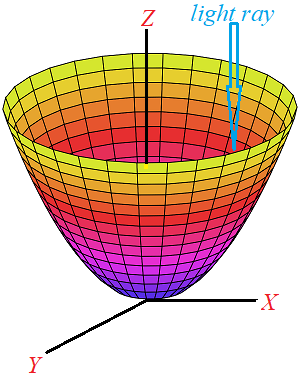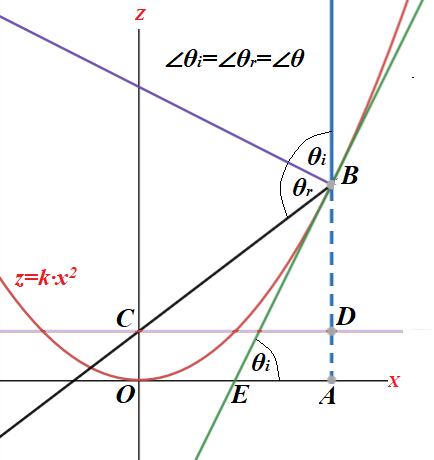Parabolic Reflector
Consider now a more complicated case of a curved reflection surface.
Any smooth surface can be considered as an infinite set of infinitesimally small flat pieces with each piece reflecting light in a direction that can be determined by a plane tangential to a surface at that point.
So, to determine the reflected light at some point of a surface we can just replace a surface with a tangential plane at that point and use the Laws of Reflection presented in the previous lecture.
Let's illustrate this on a concrete example of a paraboloid as a surface reflecting the light. Paraboloid is a surface obtained by rotating a parabola z=k·x² in the XZ-plane around the Z-axis.

As a result of this rotation, the three-dimensional formula for a paraboloid is
z = k·(x² + y²)
We will examine how vertically going down rays of light are reflected by this surface.
Assume, a light ray falls down parallel to the Z-axis of a paraboloid within XZ-plane at distance a from this axis and hits paraboloid at point B (vertical blue line on the picture below).
After the reflection off the surface of paraboloid, which we will analyze as if reflected off the tangential plane to paraboloid at point B, the reflected ray of light crosses the Z-axis of this paraboloid at point C (black line BC on the picture below).
The reflected ray of light should cross the Z-axis at some point C from the considerations of rotational symmetry of the paraboloid.
We will analyze this using a two-dimensional cut along the plane going through a point B on the surface of paraboloid, where the light ray hits its surface and the vertical axis of this paraboloid with Z-axis coinciding with the axis of paraboloid

The light blue colored line represents the light going down at a distance a=OA from the Z-axis. It hits a point B on a parabola z=k·x² (red curved line) and the solid black line represents the reflected ray of light that hits the Z-axis at point C.
The green line is tangential to a parabola at point B and should be used to determine the direction of the reflected light by establishing a normal to a parabola line (a purple line perpendicular to a green tangential line) and using the law of reflection about equality between an incidence angle θi and the reflection angle θr.
Our task is to determine a distance OC from the origin of coordinates to point C, where the reflected ray of light intersects the Z-axis of this parabola.
The analysis of this task, going from what is to be found back to what's known, is:
1. Find OC as the difference between AB (known to be the value of z=k·x² at x=a, that is k·a²) and an unknown BD.
2. To find BD, we will use the formula
BD = CD·cot(∠CBD),
where CD=OA=a
3. Angle ∠CBD is the difference between π and angle ∠θi+∠θr, that is
(since θi=θr=θ)
∠CBD = π−2θ
4. Since ∠BEA=∠θ and BE is a tangential to our parabola z=k·x², tangent of ∠BEA equals to a derivative of z=k·x² at point x=a, from which follows:
tan(∠θ) = 2k·a
Based on this analysis, we derive the following:
(a) tan(∠BEA) =
= tan(∠θ) = 2k·a
(b) tan(∠CBD) =
= tan(π−2θ) = −tan(2θ) =
= −2tan(θ)/(1−tan²(θ)) =
= 4k·a/(4k²·a²−1)
(c) cot(∠CBD) =
= 1/tan(∠CBD) =
= (4k²·a²−1)/(4k·a) =
= k·a − 1/(4k·a)
(d) BD = a·cot(∠CBD) =
= k·a² −1/(4k)
(e) OC = AB − BD =
= k·a² − (k·a² −1/(4k)) =
= 1/(4k)
So, as we see, the reflected ray of light will intersect the Z-axis at point C at a distance OC=1/(4k) from the bottom of a paraboloid.
What's remarkable about this result is that the location of point C does not depend on the value of parameter a - the distance of the incident light from the Z-axis.
So, any vertically directed ray of light will be reflected by a paraboloid towards the same point on its axis - its focal point - located at distance f=1/(4k) from the bottom, where parameter k defines the "steepness" of a paraboloid.
Using the parabolic mirror, we can "gather" the sun rays into a focal point and boil the water positioned there to use the steam to generate electricity.
If the source of light is positioned at the focal point of a parabolic mirror, all its emitted light will be directed in one direction parallel to the axis of a paraboloid. That's the principle of work of a projector.
The dish-like parabolic antenna, directed towards a stationary satellite broadcasting some radio signals, collects all the radio waves falling into it, reflecting all these signals towards its focal point, where a radio receiver is located. This allows to catch even a relatively weak radio signal.
When we don't hear a distant sound, we make a sort of a "dish" with our hand, directing the reflected sound towards the ear to hear better.
All the above examples and many others are the usages of a principle of focusing the waves by parabolic (or almost parabolic) reflectors.


No comments:
Post a Comment